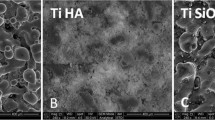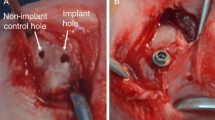Abstract
Bioactive substances may be used to enhance the rate and quantity of bone healing during osseointegration of titanium dental implants. A pilot observational study was undertaken to assess a novel keratin hydrogel in six adult sheep utilising the femoral condyles as the surgical site to assess osseointegration. Implants and osteotomy sites were coated with the keratin gel prior to implant placement (test implants) whereas the opposite knee received unmodified control implants in each animal. Fifty 3.5 mm × 7 mm Neoss dental implants were surgically implanted with a range of 3–5 Neoss dental implants placed per surgical site in each knee and allowed to heal for 5 days or 2, 4, 8, 12 and 16 weeks prior to the sheep being sacrificed. Of the 50 placed implants, 24 were used for this study and analysed via resin-embedded, undemineralised sections from test and control implants to assess the range of healing around the unloaded dental implants. These dental implants were analysed using histomorphometric methods for the best 3 consecutive threads on each side and the percentage of bone to implant contact (%BIC) was used to determine the degree of osseointegration between test and control dental implants at each time point. All implants appeared osseointegrated at the time of sacrifice. One each of the pairs of control implants at 2, 4 and 12 weeks demonstrated minimal integration histologically, with %BIC <10 %. No test implants had %BIC <35 % at any time point. Mean %BIC for test implants was higher than controls at all time points except 5 days and 2 weeks. The range from 2 to 16 weeks healing was 39.7 % [SD 25.5 %] to 85.4 % [14.2 %] for test implants and 35.6 % [43.4 %] to 46.6 % [23.1 %] for controls. %BIC appeared to increase earlier in the test implants (from 4 weeks onwards) compared to controls. After 16 weeks, %BIC was almost twice as great in test implants as controls. This pilot observational study suggests that keratin hydrogel may promote earlier osseointegration around titanium dental implants. Further cross-sectional studies with larger sample sizes are warranted. The most marked difference between test and control implants was seen after 4 weeks. It is recommended that future studies in this model focus on healing after 4 weeks.






Similar content being viewed by others
References
Le Gu’ehennec L, Soueidan A, Layrolle P, Amouriq Y (2007) Surface treatments of titanium dental implants for rapid osseointegration. Dent Mater 23:844–854
Wikesjo UM et al (2008) Bone formation at recombinant human bone morphogenetic protein-2-coated titanium implants in the posterior maxilla (Type IV bone) in non-human primates. J Clin Periodontol 35:992–1000
Ioannidou E (2006) Therapeutic modulation of growth factors and cytokines in regenerative medicine. Curr Pharm Des 12:2397–2408
Verge VM, Gratto KA, Karchewski LA, Richardson PM (1996) Neurotrophins and nerve injury in the adult. Philos Trans R Soc London B Biol Sci 351:423–430
Frostick SP, Yin Q, Kemp GJ (1998) Schwann cells, neurotrophic factors and peripheral nerve regeneration. Microsurgery 18:397–405
Sierpinski P, Garrett J, Ma J, Apel P, Klorig D, Smith T et al (2008) The use of keratin biomaterials derived from human hair for the promotion of rapid regeneration of peripheral nerves. Biomaterials 29:8
Peplow PV, Dias GJ (2004) A study of the relationship between mass and physical strength of keratin bars in vivo. J Mater Sci Mater Med 15:1217–1220
Dias GJ, Peplow PV, MvLauglin A, Teixeira F, Kelly RJ (2010) Biocompatability and osseointegration of reconstituted keratin in an ovine model. J Biomed Mater Res A 92:513–520
Freepatentsonline. Orthopaedic materials derived from keratin. United States Patent 7297342[Nov 20 2007]. Accessed at: HYPERLINK “http://www.freepatentsonline.com/7337960.html” www.freepatentsonline.com/7297342.html on 13 Sept 2009
Duncan WJ, Lee M, Dovban AS, Ershadi S, Hendra N, Ruende H (2008) Anodisation increases early integration of Osstem implants in sheep femurs. Ann R Australas College Dent Surg 19:152–156
Pearce AI, Richards RG, Milz S, Schneider E, Pearce SG (2007) Animal models for implant biomaterial research in bone: a review. Eur Cell Mater 13:1–10
Lambert P, Morris H, Ochi S (1997) Positive effect of surgical experience with implants on second-stage implant survival. J Oral Maxillofac Surg 55:12–18
Duyck J, Naert I (1998) Failure of oral implants: aetiology, symptoms and influencing factors. Clin Oral Investig 2:102–114
Melo MD, Shafie H, Obeid G (2006) Implant survival rates for oral and maxillofacial surgery residents: a retrospective clinical review with analysis of resident level of training on implant survival. J Oral Maxillofac Surg 64:1185–1189
Duncan WJ (2006) Meta-analysis of three implant experiments in the sheep mandibular model. International Association for Dental Research. General Session & Exhibition (June 28–July 1, 2006), Brisbane
Moroni A, Faldini C, Chilo V, Rocca M, Stea S, Giannini S (1999) The effect of surface material and roughness on bone screw stability. J Orthop Trauma 13:477–482
Schopper C, Moser D, Goriwoda W, Ziya-Ghazvini F, Spassova E, Lagogiannis G et al (2005) The effect of three different calcium phosphate implant coatings on bone deposition and coating resorption: a long-term histological study in sheep. Clin Oral Implants Res 16:357–368
Author information
Authors and Affiliations
Corresponding author
Rights and permissions
About this article
Cite this article
Campbell, D.I., Duncan, W.J. The Effect of a Keratin Hydrogel Coating on Osseointegration: An Histological Comparison of Coated and Non-coated Dental Titanium Implants in an Ovine Model. J. Maxillofac. Oral Surg. 13, 159–164 (2014). https://doi.org/10.1007/s12663-013-0482-y
Received:
Accepted:
Published:
Issue Date:
DOI: https://doi.org/10.1007/s12663-013-0482-y




